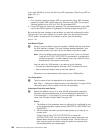– A new interface address, or
– An interface address on the same network as an existing interface.
v Choose an existing address.
To find these existing addresses, press F4 (List) when the cursor is in
this field. Then select the interface you want to use.
Note: Using this option allows this AS/400 system to serve as a proxy
for ARP requests for the remote IP address of the system dialing
in.
For more information about proxy ARP, see “Allow Proxy ARP”.
Remote IP Address:
3 If you choose an existing interface address for the local interface address,
then AS/400 uses the remote interface address for TCP/IP communications
over the point-to-point connection. If you define a new local interface
address, then AS/400 uses the remote interface address only for routing to
the remote system.
If the remote system that is dialing in expects the IP address to be passed
back to it, then the remote system uses the remote address defined here as
its local interface address for the connection.
Note: If you choose to use proxy address resolution (ARP), then this
remote IP address must be on the same subnet as the local
interface address. See “Subnetworks and Subnet Masks” on page 6
for more information about subnets.
Maximum Transmission Unit:
4 This is the size in bytes of the largest packet that AS/400 can send over the
physical line that this interface uses. Ensure that the size of the MTU is no
larger than the maximum buffer size (MAXBUFFER) parameter that is
specified for the *ASYNC line you select for this *SLIP interface.
Allow Proxy ARP:
5 Select Y if you plan to use the local interface for proxy ARP. The local
interface must be an existing interface address.
Proxy ARP-Definition:
Proxy ARP is a technique that allows one machine, the
proxy agent, to answer ARP requests that are actually destined for a different
machine. Proxy ARP is useful with SLIP because it allows a remote SLIP client to
logically appear to be part of a local network. This provides automatic connectivity
between the SLIP client and all hosts on a local network.
Proxy ARP-Example:
Consider AS/400 with an IP address of 9.4.24.93, attached
to the 9.4.24 subnet. A remote workstation dials in to AS/400. AS/400 assigns an IP
address of 9.4.24.193. to the remote workstation. AS/400 sends data for 9.4.24.193
over the SLIP line. But to all other 9.4.24.x hosts on the local LAN, 9.4.24.193
appears to be attached to the local LAN. To send data to 9.4.24.193, the other
hosts send an ARP request to 9.4.24.193. SLIP connections do not support ARP.
Without proxy ARP, the remote workstation has no way to respond to the ARP
request. If AS/400 is configured to allow proxy ARP, AS/400 answers the ARP
request for 9.4.24.193. AS/400 receives the IP packet from the originating host, and
forwards the packet on over the SLIP connection to the remote client.
Chapter 4. Configuring Point-to-Point TCP/IP (PPP and SLIP) 143


















